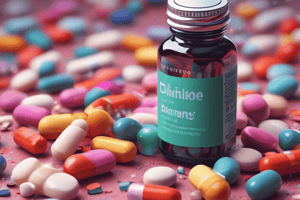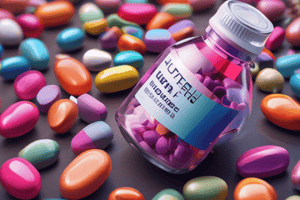Podcast
Questions and Answers
Which type of drug combination can lead to increased toxicity?
Which type of drug combination can lead to increased toxicity?
- Synergistic
- Exaggerated
- Additive (correct)
- Negation
What is the basis of an antidote or reversal agent?
What is the basis of an antidote or reversal agent?
- Synergistic
- Exaggerated
- Negation (correct)
- Additive
Which type of adverse event is often dose-related?
Which type of adverse event is often dose-related?
- Hypersensitivity
- Exaggerated normal response (correct)
- Lack of efficacy
- Toxic effects
Which type of adverse event is non-predictable and can be immediate?
Which type of adverse event is non-predictable and can be immediate?
Which factor is associated with increased risk of adverse events?
Which factor is associated with increased risk of adverse events?
Which of the following is an example of a physical interaction between a drug and its container?
Which of the following is an example of a physical interaction between a drug and its container?
Which of the following mechanisms can affect drug absorption?
Which of the following mechanisms can affect drug absorption?
Which of the following drugs is known to be a metabolism inhibitor?
Which of the following drugs is known to be a metabolism inhibitor?
Which of the following factors can alter the clearance of renally excreted drugs?
Which of the following factors can alter the clearance of renally excreted drugs?
Which of the following statements about drug interactions is true?
Which of the following statements about drug interactions is true?
Which type of drug to drug interaction occurs when the action of one drug is altered by another drug?
Which type of drug to drug interaction occurs when the action of one drug is altered by another drug?
What is the outcome of drug to drug interactions where the combined effect of the two drugs produces a result that equals the sum of the individual effects of each agent?
What is the outcome of drug to drug interactions where the combined effect of the two drugs produces a result that equals the sum of the individual effects of each agent?
Which drug to drug interaction occurs when one drug on its own does not have an effect but when coadministered with another drug it leads to a greater effect than what that drug effect would have been on its own?
Which drug to drug interaction occurs when one drug on its own does not have an effect but when coadministered with another drug it leads to a greater effect than what that drug effect would have been on its own?
Which type of drug to drug interaction occurs at a pharmaceutical level, prior to administration?
Which type of drug to drug interaction occurs at a pharmaceutical level, prior to administration?
What is the term used to describe drug combinations that produce a therapeutic or toxic effect greater than the sum of each drug's actions?
What is the term used to describe drug combinations that produce a therapeutic or toxic effect greater than the sum of each drug's actions?
Which type of drug interaction occurs when two drugs are combined and the resulting effect is greater than the sum of each drug's individual actions?
Which type of drug interaction occurs when two drugs are combined and the resulting effect is greater than the sum of each drug's individual actions?
Which type of drug interaction occurs when the action of one drug is reduced by another drug?
Which type of drug interaction occurs when the action of one drug is reduced by another drug?
Which factor is associated with an increased risk of adverse drug events?
Which factor is associated with an increased risk of adverse drug events?
Which type of adverse event is often dose-related?
Which type of adverse event is often dose-related?
What is the term used to describe drug combinations that produce a therapeutic or toxic effect greater than the sum of each drug's actions?
What is the term used to describe drug combinations that produce a therapeutic or toxic effect greater than the sum of each drug's actions?
Which of the following drugs is known to be a metabolism inducer?
Which of the following drugs is known to be a metabolism inducer?
Which of the following is an example of a physical interaction between a drug and its container?
Which of the following is an example of a physical interaction between a drug and its container?
Which of the following factors can alter the clearance of renally excreted drugs?
Which of the following factors can alter the clearance of renally excreted drugs?
Which of the following mechanisms can affect drug absorption?
Which of the following mechanisms can affect drug absorption?
Which of the following drugs can be inactivated in calcium-containing solutions?
Which of the following drugs can be inactivated in calcium-containing solutions?
Which type of drug to drug interaction occurs when the tissue/plasma levels of one drug are altered by another drug?
Which type of drug to drug interaction occurs when the tissue/plasma levels of one drug are altered by another drug?
Which drug combination produces a therapeutic or toxic effect greater than the sum of each drug's actions?
Which drug combination produces a therapeutic or toxic effect greater than the sum of each drug's actions?
Which drug is known to increase the effectiveness of penicillin by reducing its excretion in the urine?
Which drug is known to increase the effectiveness of penicillin by reducing its excretion in the urine?
Which outcome occurs when the combined effect of two drugs equals the sum of the individual effects of each agent?
Which outcome occurs when the combined effect of two drugs equals the sum of the individual effects of each agent?
Which type of drug interaction occurs at a pharmaceutical level, prior to administration?
Which type of drug interaction occurs at a pharmaceutical level, prior to administration?
Which type of drug interaction occurs when the tissue/plasma levels of one drug are altered by another drug?
Which type of drug interaction occurs when the tissue/plasma levels of one drug are altered by another drug?
What is the outcome of drug to drug interactions where the combined effect of the two drugs produces a result that equals the sum of the individual effects of each agent?
What is the outcome of drug to drug interactions where the combined effect of the two drugs produces a result that equals the sum of the individual effects of each agent?
Which drug is known to increase the effectiveness of penicillin by reducing its excretion in the urine?
Which drug is known to increase the effectiveness of penicillin by reducing its excretion in the urine?
Which type of drug interaction occurs at a pharmaceutical level, prior to administration?
Which type of drug interaction occurs at a pharmaceutical level, prior to administration?
Which type of drug combination can lead to increased toxicity?
Which type of drug combination can lead to increased toxicity?
Which type of drug combination can lead to increased toxicity?
Which type of drug combination can lead to increased toxicity?
What is the term used to describe drug combinations that produce a therapeutic or toxic effect greater than the sum of each drug's actions?
What is the term used to describe drug combinations that produce a therapeutic or toxic effect greater than the sum of each drug's actions?
Which type of drug to drug interaction occurs when the tissue/plasma levels of one drug are altered by another drug?
Which type of drug to drug interaction occurs when the tissue/plasma levels of one drug are altered by another drug?
Which type of drug interaction occurs when the action of one drug is reduced by another drug?
Which type of drug interaction occurs when the action of one drug is reduced by another drug?
Which factor is associated with an increased risk of adverse drug events?
Which factor is associated with an increased risk of adverse drug events?
Which of the following is an example of a physical interaction between a drug and its container?
Which of the following is an example of a physical interaction between a drug and its container?
Which of the following factors can alter the clearance of renally excreted drugs?
Which of the following factors can alter the clearance of renally excreted drugs?
Which drug is known to be a metabolism inducer?
Which drug is known to be a metabolism inducer?
Which type of drug interaction occurs when the action of one drug is reduced by another drug?
Which type of drug interaction occurs when the action of one drug is reduced by another drug?
Which type of adverse event is often dose-related?
Which type of adverse event is often dose-related?
What is the role of pH in drug interactions?
What is the role of pH in drug interactions?
What are some examples of drugs that can inhibit liver enzymes?
What are some examples of drugs that can inhibit liver enzymes?
How can co-administration of rifampicin affect the metabolism of warfarin?
How can co-administration of rifampicin affect the metabolism of warfarin?
Flashcards are hidden until you start studying




